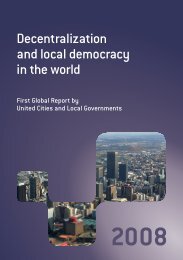Making Cities Resilient Report 2012
Making Cities Resilient Report 2012
Making Cities Resilient Report 2012
Create successful ePaper yourself
Turn your PDF publications into a flip-book with our unique Google optimized e-Paper software.
Measures for resilience building through urban planning can simultaneously improve the quality of life of<br />
residents. Although some merely compare the cost of implementing resilience activities to the benefit of<br />
saving lives and assets and conclude that investment after a disaster is more cost effective, the positive<br />
effect of resilience measures is not only limited to saving lives and assets. Measures such as securing<br />
access roads in informal settlements and upgrading and providing sufficient public space lead to overall<br />
improvement in the quality of life of a city’s residents. Measures to build resilience not only help cities to<br />
bounce back at the time of crisis, but also go hand in hand with bettering the quality of life of the residents,<br />
thus making investment in resilience pay in the long run.<br />
Measuring financing of DRR and budgets for DRR<br />
Local governments cite the lack of adequate, sustainable resources, both human and financial, as a major<br />
barrier to implementing disaster risk reduction plans. An analysis of cities involved in pilot testing the<br />
self-assessment tool revealed that Essential 2, Financing and Resources, scored lowest across of all the<br />
Essentials, meaning that this was the area in which cities felt they were making the least progress 20 .<br />
Getting an accurate account of the total city budget allocated to disaster risk reduction is not a<br />
straightforward matter, as much of the budget is mainstreamed into related programme areas, such as<br />
major urban projects and critical infrastructure. Identifying dedicated financial resources for risk reduction<br />
requires a sophisticated analysis of a city’s finances, as well as a deeper understanding of how national<br />
governments allocate and tag related spending.<br />
National studies are being conducted to track budgets related to disaster risk reduction in the Philippines,<br />
India, Indonesia, as well as in cities in Latin America. The Government of Indonesia is proposing a set of<br />
budget codes that would allow for tracking of different types of risk reduction activities and expenditures<br />
at national scale.<br />
In the context of city-level indicators, it is worth defining how municipal budgets that are owned by<br />
different departments are being used for activities related to the Ten Essentials, in addition to dedicated<br />
risk reduction budgets.<br />
As evidenced by the on-going activities presented under Essential 2 in Chapter 4, cities have tapped into<br />
different sources of financial support for disaster risk reduction (see a summary in Table 5.4). Municipal<br />
budgets are a primary source of financing. In some countries, such as the Philippines and Peru, there are<br />
national budgets for disaster risk reduction with dedicated, which can contribute to city-level budgets,<br />
that can, in turn, be complemented by third-party funding sources, such as donors, the private sector,<br />
humanitarian organisations and aid agencies. One difficulty detected at the municipal level is the lack of<br />
knowledge to articulate and initiate requests to access available national funds. In terms of indicators, or<br />
measurements of resilience, what is needed is an understanding of how budgets are being spent and how<br />
effectively this spending contributes to reducing risk for all sectors of society.<br />
20. Gawler, Steve and Alice Balbo (2011). Promoting Local Authorities Leadership for Urban Risk Reduction: ICLEI Final Project <strong>Report</strong>. ICLEI World<br />
Secretariat, Bonn, Germany.<br />
74 | <strong>Making</strong> <strong>Cities</strong> <strong>Resilient</strong> <strong>Report</strong> <strong>2012</strong>

















